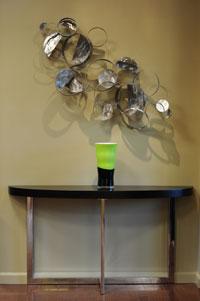Senior Editor
- FMA
- The Fabricator
- FABTECH
- Canadian Metalworking
Categories
- Additive Manufacturing
- Aluminum Welding
- Arc Welding
- Assembly and Joining
- Automation and Robotics
- Bending and Forming
- Consumables
- Cutting and Weld Prep
- Electric Vehicles
- En Español
- Finishing
- Hydroforming
- Laser Cutting
- Laser Welding
- Machining
- Manufacturing Software
- Materials Handling
- Metals/Materials
- Oxyfuel Cutting
- Plasma Cutting
- Power Tools
- Punching and Other Holemaking
- Roll Forming
- Safety
- Sawing
- Shearing
- Shop Management
- Testing and Measuring
- Tube and Pipe Fabrication
- Tube and Pipe Production
- Waterjet Cutting
Industry Directory
Webcasts
Podcasts
FAB 40
Advertise
Subscribe
Account Login
Search
Shaking off the albatross of manufacturing’s image
High-end design meets the job shop
- By Tim Heston
- August 1, 2011
- Article
- Shop Management
U.S. manufacturing has led this economic recovery. Reports trumpet the industry’s quality and productivity. Yet the profession still has image problems, even if the reality is so different. In the job shop arena, it’s about fast response, changing over jobs quickly, flowing part kits from one workcell to the next. The fabrication process engages the mind like never before. Workers practicing continuous improvement meet regularly to discuss shop floor layout, batch sizes, machine setup options, tooling organization and identification, and job tracking. It’s a juggling act that rewards clear thinking and logic.
Of course, most people wouldn’t see all this activity after spending just a few minutes at a company. Shop floors tend to look like big garages, a place where form follows far behind function. Like garages, may shops may not look very inviting for those who didn’t grow up tinkering in a garage of their own—and nowadays this describes most people entering the work force.
Jeanette Cataldo hoped to change this, at least for one shop. The interior designer based near Boston had concentrated mainly on corporate offices before getting a call from MK Services (www.mks-corp.com), a job shop in nearby Danvers, Mass. The company has a strong foothold in the medical industry and the shop owner wanted to make lasting first impressions on visiting customers.
To research the industry, Cataldo visited several job shops, but before long she knew she had to take an entirely different approach. She didn’t sugarcoat what she saw, either: “They looked like depressing places to work.”
Now MK Services is anything but depressing. The front office is sleek and memorable; (see Figure 1) the shop floor exudes a high-tech feel; (see Figure 2) and the quality assurance room “looks a lot like a laboratory,” Cataldo said (see Figure 3). “We wanted to give the shop some color and light. We wanted employees to walk in there and feel good. And now they do—they love it. When you walk in there, you don’t know you’re walking into a typical job shop. It’s a very contemporary setting.”
The waiting room alone makes a memorable impression (see Figure 4). Stainless steel elements line the walls, and a welded sculpture in the center of the waiting area includes a variety of parts the company has made (see Figure 5 ). “Anyone who does business with this shop will recognize those parts,” Cataldo said.
“Our client said it was jaw-dropping,” she added. “He can’t wait to take his customers on tours.”
The investment may well pay off not just for external customers, but for internal ones too. Employees spend most of their lives at work, after all. True, design alone can’t improve an organization’s quality or profitability. Case in point: Enron’s beautiful headquarters building didn’t prevent the company’s collapse. But when it comes to shaping perceptions, looks matter—and good first impressions may help manufacturing shake off its bad-image albatross.
Images courtesy of Jeanette Cataldo Design & Construction, 416 Main St., Saugus, MA 01906, 781-231-0238, www. jcataldoconstruction.com.
About the Author

Tim Heston
2135 Point Blvd
Elgin, IL 60123
815-381-1314
Tim Heston, The Fabricator's senior editor, has covered the metal fabrication industry since 1998, starting his career at the American Welding Society's Welding Journal. Since then he has covered the full range of metal fabrication processes, from stamping, bending, and cutting to grinding and polishing. He joined The Fabricator's staff in October 2007.
subscribe now

The Fabricator is North America's leading magazine for the metal forming and fabricating industry. The magazine delivers the news, technical articles, and case histories that enable fabricators to do their jobs more efficiently. The Fabricator has served the industry since 1970.
start your free subscription- Stay connected from anywhere

Easily access valuable industry resources now with full access to the digital edition of The Fabricator.

Easily access valuable industry resources now with full access to the digital edition of The Welder.

Easily access valuable industry resources now with full access to the digital edition of The Tube and Pipe Journal.
- Podcasting
- Podcast:
- The Fabricator Podcast
- Published:
- 04/16/2024
- Running Time:
- 63:29
In this episode of The Fabricator Podcast, Caleb Chamberlain, co-founder and CEO of OSH Cut, discusses his company’s...
- Trending Articles
Steel industry reacts to Nucor’s new weekly published HRC price

How to set a press brake backgauge manually

Capturing, recording equipment inspection data for FMEA

Are two heads better than one in fiber laser cutting?

Hypertherm Associates implements Rapyuta Robotics AMRs in warehouse

- Industry Events
16th Annual Safety Conference
- April 30 - May 1, 2024
- Elgin,
Pipe and Tube Conference
- May 21 - 22, 2024
- Omaha, NE
World-Class Roll Forming Workshop
- June 5 - 6, 2024
- Louisville, KY
Advanced Laser Application Workshop
- June 25 - 27, 2024
- Novi, MI



























